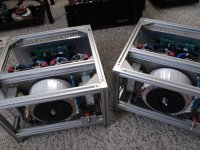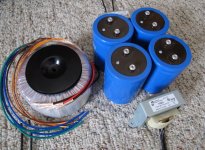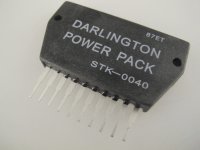SMPSs are used more & more in audio power amplifiers these days.
I hear that even the best of them do not apparently last more than 5 years (is this really true ?).
How can I immortalize one to run into 20 or so years (replace all caps with better and higher temp caps) ?
I hear that even the best of them do not apparently last more than 5 years (is this really true ?).
How can I immortalize one to run into 20 or so years (replace all caps with better and higher temp caps) ?
At least, and with all of the parts rated at higher temp and voltage, and better heat sinking.
But many commodity PC supplies last much longer than 5 years.
But many commodity PC supplies last much longer than 5 years.
Ventilation and good brand (which choose to spec quality rather than price) is the key to longevity.
They fail prematurely because of lack of ventilation (or poor heatsinking) or cheap spec parts.
They fail prematurely because of lack of ventilation (or poor heatsinking) or cheap spec parts.
I was specifically thinking of the Hypex SMPS1200 and Icepower S1500 power supplies. They are 'claimed' to be very reliable and robust, but I still have my doubts. Could they ever be as reliable as a big iron 1000 VA transformer, a 100 amp rectifier and 105 degree 20,000 hour filter capacitors ?
Everything has connectors and solder joints, so there are limits.
Thermal cycling is a big killer, along with vibration for mobile.
Thermal cycling is a big killer, along with vibration for mobile.
Last edited:
An SMPS is fine if treat properly.
Some people try to hang 10,000uf caps off the output then wonder why the trip out.
For reliability best solution is old school trafo, rectifier and big smoothing caps.
Some people try to hang 10,000uf caps off the output then wonder why the trip out.
For reliability best solution is old school trafo, rectifier and big smoothing caps.
All equipment can fail. That is managed by either skilling yourself up to repair the equipment (and keeping at least critical parts on the shelf), or keeping spare equipment on the shelf ready to replace.
Unless you intimately know the design of some equipment it may be naive to think that changing some parts can bullet-proof performance. Certainly ambient temperature and cooling can be important in failure rate, but again that depends on design and parts selection and whether you are guru enough to quantify that issue for the particular equipment you are concerned about and if the first failure you experience is actually related to temperature.
Bullet proofing a simple mains frequency power supply is easier to engineer because design details are generically well known, and parts count is smaller. It's well worth noting that equipment failure rate is related to the number of parts in the equipment, so many smps are way behind in that aspect of reliability assessment because of the much larger number of parts used.
In your situation I would advise to purchase spare equipment and keep it on the shelf if you really are concerned.
Unless you intimately know the design of some equipment it may be naive to think that changing some parts can bullet-proof performance. Certainly ambient temperature and cooling can be important in failure rate, but again that depends on design and parts selection and whether you are guru enough to quantify that issue for the particular equipment you are concerned about and if the first failure you experience is actually related to temperature.
Bullet proofing a simple mains frequency power supply is easier to engineer because design details are generically well known, and parts count is smaller. It's well worth noting that equipment failure rate is related to the number of parts in the equipment, so many smps are way behind in that aspect of reliability assessment because of the much larger number of parts used.
In your situation I would advise to purchase spare equipment and keep it on the shelf if you really are concerned.
Last edited:
An SMPS is fine if treat properly.
Some people try to hang 10,000uf caps off the output then wonder why the trip out.
For reliability best solution is old school trafo, rectifier and big smoothing caps.
Hi Nigel, it is interesting that you mentioned connecting large caps to the output of an SMPS is not a good idea.
I was actually thinking of doing exactly that. But, to alleviate the short circuit effect at power on, I was also going to put an inrush current limiter to the input, which will limit the current to about 4 amps (33 ohm, 150 watt power resistor for 120 V US supply) for about 3-4 seconds, which would then be shorted out with a timer relay (typical simple inrush current limiter). Given that and knowing that the input current can never exceed 4 amps for the first 3-4 seconds, how can the device possibly be damaged even if very large caps are placed across the output ?
Thanks
My Benchmark DAC and power amp are 6-7 years old, functioning perfectly, and I expect them to do so for many more years.
My Benchmark DAC and power amp are 6-7 years old, functioning perfectly, and I expect them to do so for many more years.
Do they run on an SMPS ?
Give me a BIG LINEAR P/S
Simple, fewer parts (issues with failure), beefy point to point wiring,
[if built properly] offer great power regulation ~ and ~ most importantly,
great(er) ~ DYNAMIC HEADROOM ~ do not serve as current limiters.
I built 3 pairs of brute force "lab type" power supplies for testing
several amplifier typologies, A-B (currently), ICE power and Hypex.
(eventually)
The dynamics of BIG LINEAR SUPPLIES
are difficult to equal. Nearly scary!
While I am not a fan of SMPS, the "Hypex 1200 watt"
unit would be one I would consider using,
it has "proven itself".
"The nature of what" capacitors are exposed to,
how they are used in SMPS, failure IS CERTAIN to occur
at a much earlier intervals / life cycles, I think
.that is a given.
As mentioned elsewhere, about SMPS "enhancements"
NO CAPACITORS on the output = very BAD IDEA.
Use (2) 1200's if you need to advance performance.
Simple, fewer parts (issues with failure), beefy point to point wiring,
[if built properly] offer great power regulation ~ and ~ most importantly,
great(er) ~ DYNAMIC HEADROOM ~ do not serve as current limiters.
I built 3 pairs of brute force "lab type" power supplies for testing
several amplifier typologies, A-B (currently), ICE power and Hypex.
(eventually)
The dynamics of BIG LINEAR SUPPLIES
are difficult to equal. Nearly scary!
While I am not a fan of SMPS, the "Hypex 1200 watt"
unit would be one I would consider using,
it has "proven itself".
"The nature of what" capacitors are exposed to,
how they are used in SMPS, failure IS CERTAIN to occur
at a much earlier intervals / life cycles, I think
.that is a given.
As mentioned elsewhere, about SMPS "enhancements"
NO CAPACITORS on the output = very BAD IDEA.
Use (2) 1200's if you need to advance performance.
Attachments
Do you think it matters whether the SMPS is regulated or not? I would assume that the regulated ones would not require further smoothing.
iI agree that noise and regulation are not directly related. That was not my point. I was suggesting that a regulated supply, whether linear or SMPS needs a large decoupling/smoothing capacitor on its output?
Last edited:
My Lenovo T500 laptop is 14 years old and the SMPS psu is also still alive. It's also still in use as linux machine to experiment with. Good SMPS's can live as long as good linear psu's. The problem is the massive ammount of crap smps's that are arround to power our throw away electronics of today.
apples and oranges man
(I am sorry but) A SMPS that will last for ions, does not readily translate into a P/S solution that will provide lasting service and sound even .reasonably. good. Of course, not everyone shares the same standards for quality.
The dynamic load of music playing in a amplifier ~ is vastly different ~ than a fairly static load represented in and by a computer as seen by the power supply.
My Lenovo T500 laptop is 14 years old and the SMPS psu is also still alive. It's also still in use as linux machine to experiment with. Good SMPS's can live as long as good linear psu's. The problem is the massive ammount of crap smps's that are arround to power our throw away electronics of today.
(I am sorry but) A SMPS that will last for ions, does not readily translate into a P/S solution that will provide lasting service and sound even .reasonably. good. Of course, not everyone shares the same standards for quality.
The dynamic load of music playing in a amplifier ~ is vastly different ~ than a fairly static load represented in and by a computer as seen by the power supply.
An SMPS is fine if treat properly.
Some people try to hang 10,000uf caps off the output then wonder why the trip out.
For reliability best solution is old school trafo, rectifier and big smoothing caps.
I finally went down the custom iron route with toroid transformers and toroid chokes. Only silicon at the moment is in the inrush limiting for the cap banks of the heater supply (filtered RC) but that's a LM317 sitting on the shoulder of a 30A capable BJT, the solid state then bypasses once it's up and running. In theory.. the initial version will simply not bother and run AC heaters..
If you have a DC regulated power supply- then you have a SMPS capable amp.
The issue is that in 20 years time, a lot of the supply ICs will be gold dust. The real issue with SMPS is the transformers - those will simply disappear and you'll need to custom wind a replacement. If it's a resonant stage then a mishap with the cap will probably take out the transformer windings and burn the PCB.
I'm still tempted given the space/mass saving. However I want to build tube amps that outlast me.
For scaling SMPS - one option is to use medical power supplies. The MEANWELL medical supplies even have a series that can be paralleled with a current sharing bus between the supplies. Also the supplies outputs are not frame grounded, leaving the output grounding to the designer IIRC when I was researching them.
Last edited:
Linears supplies are .pretty simple.
Most people (it seems) appear to over look, there are "advantages" to
manufacturers and DIY'ers on a budget or building to price points,
a singular [very narrow] advantage to SMPS in high power amps.
*ones available to DIY world.
Massive chassis case work are not required to house
BIG ~ HEAVY ~ chassis torquing power supply parts.
~ saving HUGE amount of the build budget(s) ~
It is easy(ier) to achieve great stability and **better headroom,
greater ebb and flow, with dynamic slam... and realism.
**sorry to (seem to) keep screaming that.
with ~ beefy ~ linear supplies.
Capacitive loading a(ny) SMPS will not solve or even offset
any fundamental design limitation(s) ~ of something [PS]
that "is always holding back".
SMPS [to me] are much like the Darlington Power Packs,
dreadful IC output stages = so compromised / but compact,
appeared in the 70s-80s, a huge downfall field of HiFi.
Those aware stayed with discrete transistor designs.
Or vacuum tubes.
Most people (it seems) appear to over look, there are "advantages" to
manufacturers and DIY'ers on a budget or building to price points,
a singular [very narrow] advantage to SMPS in high power amps.
*ones available to DIY world.
Massive chassis case work are not required to house
BIG ~ HEAVY ~ chassis torquing power supply parts.
~ saving HUGE amount of the build budget(s) ~
It is easy(ier) to achieve great stability and **better headroom,
greater ebb and flow, with dynamic slam... and realism.
**sorry to (seem to) keep screaming that.
with ~ beefy ~ linear supplies.
Capacitive loading a(ny) SMPS will not solve or even offset
any fundamental design limitation(s) ~ of something [PS]
that "is always holding back".
SMPS [to me] are much like the Darlington Power Packs,
dreadful IC output stages = so compromised / but compact,
appeared in the 70s-80s, a huge downfall field of HiFi.
Those aware stayed with discrete transistor designs.
Or vacuum tubes.
Attachments
Last edited:
DING!
~ e x a c t l y ~
I am with you building gear that will outlast me,
and / or who ever is using my gear.
I finally went down the custom iron route with toroid transformers and toroid chokes.
I want to build tube amps that outlast me.
~ e x a c t l y ~
I am with you building gear that will outlast me,
and / or who ever is using my gear.
- Home
- Amplifiers
- Power Supplies
- SMPS in audio


